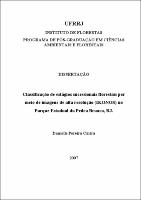Please use this identifier to cite or link to this item:
https://rima.ufrrj.br/jspui/handle/20.500.14407/11192| Tipo do documento: | Dissertação |
| Title: | Classificação de estágios sucessionais florestais por meio de imagens de alta resolução (Ikonos) no Parque Estadual da Pedra Branca, RJ |
| Other Titles: | Classifying successional forests using high resolution image (Ikonos), in Pedra Branca State Park, RJ |
| Authors: | Cintra, Danielle Pereira |
| Orientador(a): | Oliveira, Rogério Ribeiro de |
| Primeiro coorientador: | Rego, Luiz Felipe Guanaes |
| Keywords: | sensoriamento remoto;sucessão ecológica;Floresta Atlântica;remote sensing;forest succession;Atlantic tropical forest |
| Área(s) do CNPq: | Recursos Florestais e Engenharia Florestal |
| Idioma: | por |
| Issue Date: | 3-Aug-2007 |
| Publisher: | Universidade Federal Rural do Rio de Janeiro |
| Sigla da instituição: | UFRRJ |
| Departamento: | Instituto de Florestas |
| Programa: | Programa de Pós-Graduação em Ciências Ambientais e Florestais |
| Citation: | CINTRA, Danielle Pereira. Classificação de estágios sucessionais florestais por meio de imagens de alta resolução (Ikonos) no Parque Estadual da Pedra Branca, RJ. 2007. 74 f. Dissertação (Mestrado em Ciências Ambientais e Florestais) - Instituto de Florestas, Universidade Federal Rural do Rio de Janeiro, Seropédica - RJ, 2007. |
| Abstract: | A tecnologia de geração de imagens obtidas por sensores remotos instalados em satélites artificiais foi essencial para evolução dos estudos ambientais. No caso do monitoramento de florestas esta tecnologia é de grande importância para avaliar a cobertura e dinâmica da floresta e a detecção de alterações ambientais causadas por fatores naturais ou de origem antrópica. Este trabalho se concentra na bacia do rio Camorim, parte meridional do Parque Estadual da Pedra Branca, que se encontra na Região Metropolitana do Município do Rio de Janeiro. O objetivo do estudo foi diferenciar estágios sucessionais florestais através de uma classificação baseada em interpretação visual de uma imagem orbital de alta resolução. A classificação da imagem obedeceu a uma hierarquia de classes do nível geral (Nível I) para o específico (Nível II). As formações florestais foram classificadas de acordo com a resolução CONAMA nº. 06 de 04/05/1994 em diferentes estágios de sucessão secundária (estágio inicial, estágio médio, estágio avançado e floresta primária). Cada uma dessas classes teve suas coordenadas obtidas em campo através de GPS. A partir dos dados coletados em campo e a transferência dos dados obtidos com o GPS à imagem, foi definida uma chave de interpretação. Verificou-se que 85% da área total da bacia do rio Camorim é ocupada por floresta em diferentes estágios de sucessão ecológica. As áreas em estágio mais avançado de sucessão (estágio avançado e floresta primária) se equiparam em extensão às áreas em estágios mais iniciais (estágio médio e inicial), ocupando 336 ha (42%) e 328 ha (41%), respectivamente. Isso significa que apesar da grande pressão antrópica que sofre em seu entorno, a bacia do rio Camorim ainda mantém remanescentes importantes para conservação da Mata Atlântica. A estratégia de classificação por hierarquia de classes se mostrou um bom método para interpretação visual das classes, que por ser sistemática diminui a subjetividade do processo. A metodologia aplicada permitiu a diferenciação dos estágios sucessionais. O resultado, no entanto representa uma estimativa, muito útil principalmente para melhorar a atuação dos órgãos fiscalizadores e gestores da região. |
| Abstract: | The technology of image generation by remote sensing was extremely important for the environmental studies evolution. In the case of forest monitoring, this technology is important to evaluate forest cover and dynamics and detection of environmental changes from natural or human causes. This work concentrates on the basin of the river Camorim, it leaves southern of the Pedra Branca State Park, metropolitan area of the municipal district of Rio de Janeiro. The goal of the study was to differentiate forest succession stages through visual interpretation of a high resolution orbital image. The image classification obeys a hierarchy of classes from a general level (Level I) to a specific level (Level II). The forest formations were classified according to CONAMA resolution nº. 06 de 04/05/1994 in different secondary successional stages as initial, medium, advanced stage and primary forest. Each of them had geographic coordinate acquired in the field by GPS. From the data collected in field in the area of study and the transference of the data acquired with the GPS to the image, an interpretation key was defined. In the case of this work the color tonality and texture aspects had been taken in consideration, for distinction of the different sucessionais stages. It was verified that 85% of the total area of the basin of the river Camorim are covered by forest in different stages of ecological succession. The areas in more advanced stage of succession (advanced stage and primary forest) had equalized in extension to the areas in initial stage (average and initial stages), occupying 336 ha (42%) and 328 ha (41%), respectively. This means that although the great human pressure that suffers in its neighborhood, the basin of the river Camorim still keeps important remainders for conservation of Atlantic Forest. The strategy of classification for hierarchy of classes was a good method for visual interpretation. That diminishes a little of the subjectivity of the process for being systematic. The applied methodology allowed the differentiation of the sucessionais stages. The result however represents an estimate, very useful mainly to improve the performance of the environmental control agencies and managers of the region. |
| URI: | https://rima.ufrrj.br/jspui/handle/20.500.14407/11192 |
| Appears in Collections: | Mestrado em Ciências Ambientais e Florestais |
Se for cadastrado no RIMA, poderá receber informações por email.
Se ainda não tem uma conta, cadastre-se aqui!
Files in This Item:
| File | Description | Size | Format | |
|---|---|---|---|---|
| 2007 - Danielle Pereira Cintra.pdf | 2.42 MB | Adobe PDF |  View/Open |
Items in DSpace are protected by copyright, with all rights reserved, unless otherwise indicated.

